Runnymede is famous for the signing of the Magna Carta in 1215 by King John and his Barons.
Many people widely accept the Magna Carta as the first constitutional document that formed the basis of modern democracy. Indeed, the American Bar Association funded and erected the monument to the Magna Carta.
Today, the National Trust owns Runnymede, a very attractive meadow. The site is just a couple of miles south of Windsor, near Old Windsor, the original settlement before the castle was built up river and sits adjacent to the River Thames.
There is a public bus service from Windsor to within a few hundred metres of the Runnymede site. Broadly the service runs every 30 minutes, hourly early mornings, evenings and Sundays.
During the warm summer days, the grassy areas along the River Thames become accessible for vehicles, making it a wonderful spot for a picnic when the weather is nice. Moreover, there is a charming tea house with a small, sturdy parking lot located near the entrance to Runnymede at the Old Windsor side.
Today, people can see three monuments.. One is of course to commemorate the Magna Carta. A second, erected in the 1960s to remember the assassinated US president, John F Kennedy.
Lastly at the top of the hill is the Air Forces Memorial. There is totally free access to Runnymede, the only charges are for car parks.
A walk through Runnymede to view the monuments
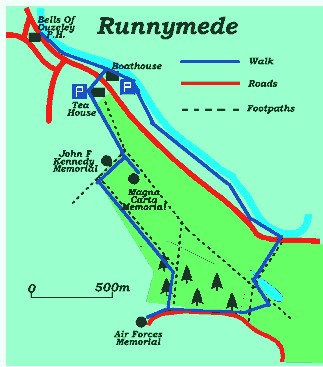
If you are arriving by bus, get off at the Bells of Ouzeley Pub at the southern tip of Old Windsor. If you have your own transport see if you can park around the tea house, where there is a fee for parking.
From the Bells of Ouzeley, cross to the other side of the road and follow the riverside path, parallel to the road away from Windsor (going south). After about 100m the path veers of left away from the road to follow the river, by a road junction.
After passing a house on your right you come to a boathouse, the operational base of French Brothers pleasure boats. At the boathouse turn right down the access road to the main road and continue over to the other side and the tea house with its car park.
At the corner of the car park facing the meadow is a noticeboard with a map and various signs to the memorials – you can’t go wrong.
Magna Carta Memorial
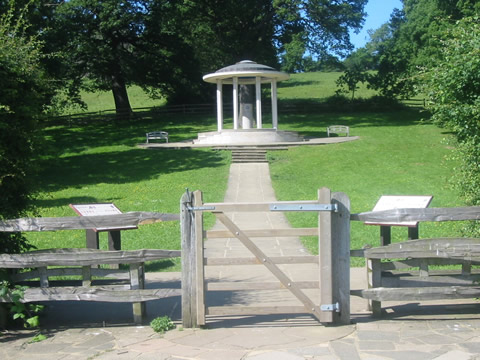
There is a clear path going diagonally across the meadow in front of you to the foot of the hillside. Pass the turnoff on your right to the John F Kennedy memorial, but keep a mental note we will be returning. After a hundred metres you come to the Magna Carta memorial pictured right.
A brief history
In the year 1215, King John’s poor leadership had pushed him to the brink of a civil war with his barons. While King John took refuge in Windsor Castle, the rebellious barons set up their camp in Staines, with Runnymede conveniently located right in the middle of their opposing positions.
The agreement reached at Runnymede was the Magna Carta, a statement of some basic principles. The key principle was that no citizen could imprison or outlaw another without a lawful judgment made against the stated laws of the land. For King John, a significant takeaway was the necessity of adhering to the law himself.
The United States of America used the Magna Carta as a reference for their constitution and arguably finds it of more historical significance than the UK. Indeed, the American bar erected the memorial on the site, not the British.
JFK Memorial
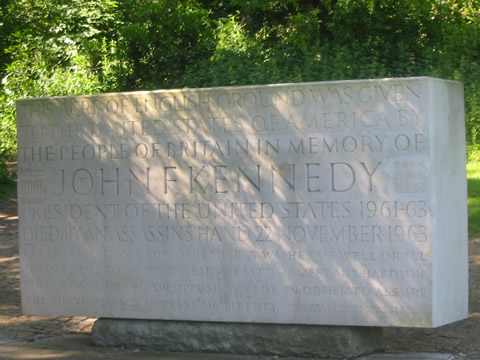
Retrace your steps to the turnoff to the John F Kennedy Memorial. The memorial is half way up the hill in front of you through the trees. A clear well maintained paved path takes you there.
The Kennedy Memorial stands in its own acre of land, given by the people of Britain to the USA, honouring the memory of the assassinated President. A little piece of America by the Thames.
After the monument continue uphill, we are now on our way to the third and final monument – the Air Forces Memorial.
After a couple of minutes you see on your left a gate with public footpath signs giving access to the field beyond. It is not well signed that it is a public right of way, but it is. Pass through the pedestrian gate. The path is not well defined but soon opens out to a panoramic view of Runnymede meadow below. Further along there is an isolated bench to sit on with a grade A view.
After about 750m the path descends to some woods, you will see a stile, your entrance to the woods. Within the woods the path is very well defined. After a while there is a major fork in the path, it doesn’t really matter which one you take, the right hand fork is slightly shorter.
Whichever path you take, very soon a major path crosses your path going up the hill. Take this path up the top of the hill where it meets a lane. Turn right into the lane which leads you to the air forces memorial.
Air Forces Memorial
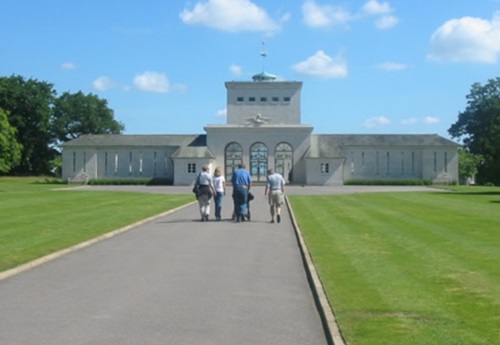
The Air Forces Memorial at Runnymede commemorates by name over 20,000 airmen and women who were lost in the Second World War during operations from bases in the United Kingdom and North and Western Europe, and who have no known graves. They served in Bomber, Fighter, Coastal, Transport, Flying Training and Maintenance Commands, and came from all parts of the British Commonwealth.
The names in their thousands are inscribed on panels in a courtyard. The memorial (see picture right) is at the top of the hill with fine views over Runnymede and beyond. There are tributes at all times, but at times of anniversaries like D Day the tributes can be quite moving.
In reflective thought, retrace your steps down the lane. If you want to go directly back to the start, when you come to the path you climbed take it again but all the way down onto Runnymede meadow. If you’re game for a nice walk keep going down the lane as it gently descends.
In about ten minutes the lane makes a turn to the right, just before on your left the land opens up and you can see a small lake below. There is a gate giving access down the hill to the lake, take it. Make your way to the water below. The water is called Langham Pond.
Follow the left bank of the pond. After a while you enter a small clump of woodland and the path becomes a boardwalk. The boardwalk turns and crosses the northern tip of Langham Pond. On the other side of the pond, our route is indistinct. If you’ve good sight you may see our goal, a style by a footpath sign over by the road in the far distance. If not, set off at about an angle of 20 degrees to straight ahead across the meadow – the sign and style will eventually come into view.
On reaching the road cross over to the other side and the River Thames. Turning left, follow the riverside path all the way back to the Bells of Ouzeley.
Pleasure boats at Runnymede
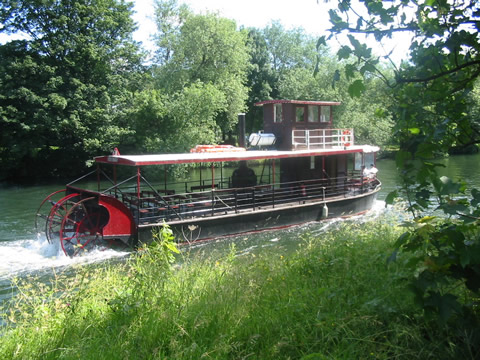
French Brothers Riverboats
Just by the river at the entrance to Runnymede at the Old Windsor end is a small boatyard.
French Brothers operate pleasure boats along the river from here on short trips, the star being the Lucy Fisher. Originally built for the 1984 film “Tarzan – the legend of Greystoke”, the Lucy Fisher is a replica of an African Paddle steamer.
Built in two halves she was shipped to location in the Cameroons, and was artificially aged to reflect the true character of the era. Since then it has appeared in many films and TV programmes.
French Brothers primarily operate from the Windsor Riverfront, offering a variety of services right in Windsor. Throughout the summer, they provide regular short boat trips from this location, along with special excursions to Windsor and Hampton Court on occasion.
For more information on trips available visit the French Brothers Windsor web site.